
Check out all of articles in the Fall edition of Long Range Shooting, GunsAmerica’s newest specialty publication.
Precision Rifle Shooting (PRS) has been gaining a lot of ground in recent years and with that an increasing interest in precision rifle competitions. I started shooting precision rifle competitions about 12 years ago and back then, the competitive landscape was different. There weren’t as many matches around as I was getting into it and there certainly weren’t any standardized rules about what was and wasn’t allowed. I don’t want to say we live in a “Golden Age” of PRS but it is a pretty good time to get into the sport because it’s as easy as its ever been to get started. There are more matches, it’s easier to access information about venues, and there is a huge assortment of equipment to fit any budget. Starting out can be pretty intimidating and this article is to be but one in a series of articles to help those interested in competing in PRS.
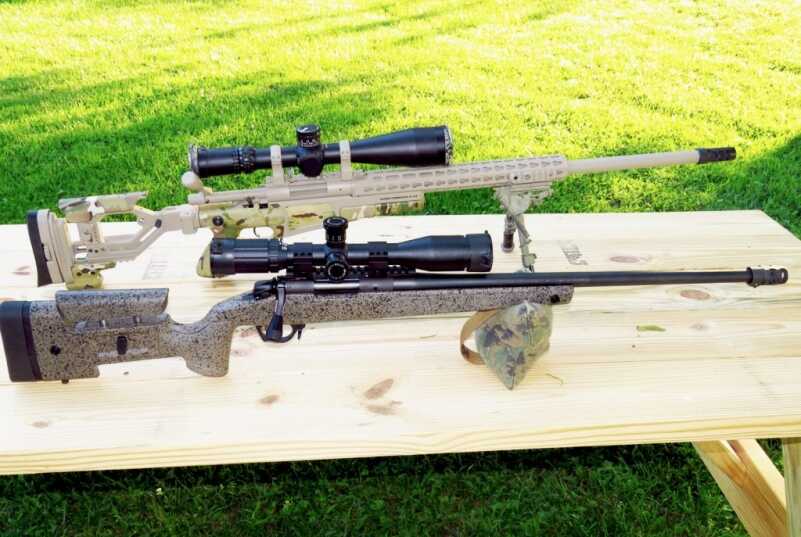
Even though these rifles look dramatically different they have similar aspects that make them suitable for precision rifle competitions.

A bipod is a necessity for precision rifle competitions. Don’t get the cheap versions sold in big box stores as they will let you down.
Mindset
Yogi Berra famously said: “Baseball is 90 percent mental and the other half is physical.” As odd as it sounds there’s some truth to that, the mental game is as important as the physical game. Having a good mindset going into your first precision rifle match is going to allow you to do better and have a better time while you are at it. My advice is that even though you might be nervous and that’s to be totally expected, the number one thing you can do is take it one stage at a time. I wouldn’t worry about how many targets you missed, where you are in the results, or what you might pick up off the prize table. Focusing on those things is an excellent way to go down in flames.

The way that I keep myself basically in the stage is to have a mental checklist that I run through before and after I’ve done a stage. It’s not fancy and the more simple it is the better. It’s basically a series of questions to make sure I’m ready. I need to know where my targets are, is the scope is set up correctly for the stage, do I have plenty of ammo, and do I have the necessary support gear to get me through. Coming off of the stage, my checklist is to make sure that I reset my scope settings, I have all the gear I went up there with, and that I discard any data cards before the next stage. When you hit your first match go in with an open mind ready to accept some constructive criticism from the more veteran competitors and have FUN.
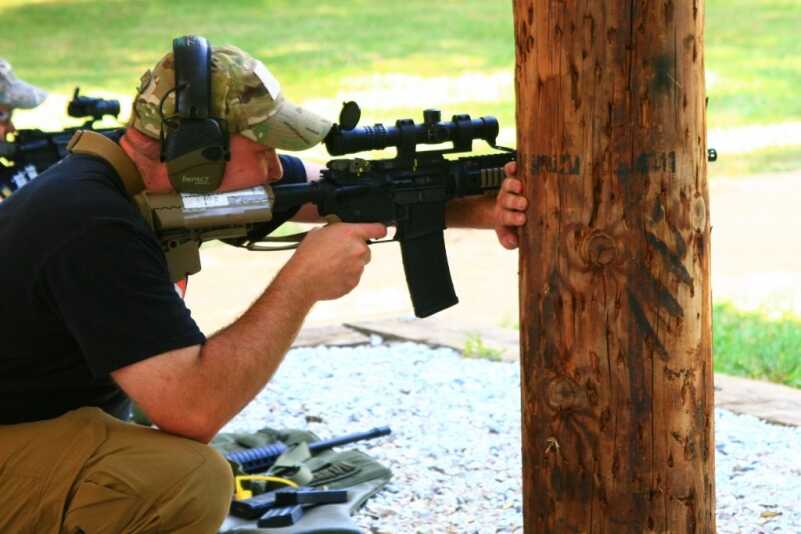
Something as simple as knowing to lift your firing knee instead of dropping it so you can support your elbow can greatly increase stability and accuracy.
Article Continues Below
Equipment
The question on the lips of every new competitor’s is, what should I buy? It’s a reasonable question but one with many answers. As a new shooter be prepared to hear the tired old mantra of “buy once cry once,” it’s almost as played out as slow is smooth and smooth is fast. My advice is to buy the best that you can afford and focus your funds on getting the essentials that will allow you to start competing. I’m not going to recommend a certain brand or model in this article, only to list out some basic criteria for what will work to get you going in your first match.

A good optic doesn’t have to break the bank. This Burris XTR II costs right around $1,100 but it has features that you easily would’ve paid double for less than a decade ago.

It will also be helpful to work on some more traditional shooting techniques like shooting in a sitting position using a sling.
Obviously, any conversation about precision rifle competitions needs to start with the rifle. For a first timer, I recommend a good bolt-action. Typically, a bolt action rifle is going to give the best bang for the buck in terms of cost, reliability, and accuracy right out of the box. There are a few features that you’ll want your bolt action to have, which will make it a better competition rifle.
- A medium to heavy contour barrel that is free floated in the stock will promote consistent barrel harmonics for better accuracy over long strings of fire.
- The stock should be made from a rigid material not only for strength but also for rigidity so that it can stand up to all sorts of abuse. In order to be competitive, the rifle should be set up a detachable magazine system, preferably one that accepts Accuracy International pattern magazines.
- I recommend that you get at least two 10-round magazines. You can purchase more, but two will suffice as you get started.
It’s not that hard in today’s market to find a rifle that can check a lot of the boxes for someone seeking their first comp gun and not break the bank. Some really good options are out there for right around $1,000 and will hang with some of the more expensive custom rifles.

Parallax adjustment is also a must so that the shooter can get a crisp, clear image of the target at long distance.
As important as the rifle is, the optics setup that you choose is going to be just as if not more important so don’t skimp when it comes to these purchases. A typical 3-9X hunting scope isn’t going to cut it at a match. Fixed magnification optics used to be predominant, however, advances in manufacturing have made variable power optics extremely durable and reliable. For this reason, you need a variable power optic that includes:
- Magnification range of 3-12X, which will give you a good balance of internal elevation, field of view, and the ability to see hits or misses.
- The elevation and windage turrets should have adjustments that match the reticle graduations and parallax adjustment should be a must.
- Buy a good one-piece 20 MOA Picatinny base and for just about all short action calibers, an aluminum base will be just fine.
- The scope rings need to be heavy-duty type rings, precision machined so that they will be aligned when they are mounted on the base.
Again, there are companies now making very good optics that you can use for precision rifle matches that don’t require you to take out a second mortgage and give you many of the features above. When it comes to the mounting solutions you want to buy the best that you can afford and be wary of deals that appear to be too good to be true. Buying high-quality rings and bases are going to mitigate the chances of misalignment and zero issues when you hit the range.

There are a ton of shooting bags available for PRS matches. Starting out though a good rear bag will be all that’s needed to get started.
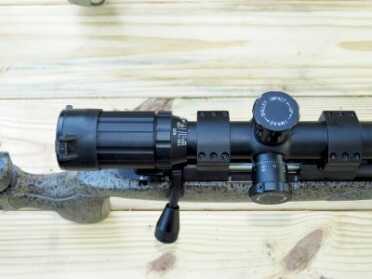
A suitable optic for PRS will have turrets that are resettable to zero and match the reticle inside the scope.
After you sort out the rifle and optics your equipment journey isn’t over, you still need to get a bipod, a rear bag, and a databook, and that’s just for starters. A Harris bipod has been the choice of many long range shooters for many, many years including those in the military and law enforcement circles. I favor the S-BRM bipod that is adjustable from 6 inches to 9 inches with notched legs and it can also swivel from side to side to compensate for uneven ground.
A good rear bag is going to be one of the most versatile pieces of gear that you buy because it can not only support the rear of the rifle, it can also act as a front bag off of barricades or under your leg in other field positions. Stay away from the typical benchrest rear bags that are very firm and have the bunny ears, they are not as versatile as a rectangular or cylindrical rear bag.
Lastly, a modular data book is going to be a vital tool for recording information about the rifle so that you can use it later. I prefer modular data books because they can be rearranged to remove or insert pages that will be helpful to you and your style of shooting.

In order of importance for the author are the databook, the Kestrel weather meter and, finally, the Leica laser rangefinder.
Sophisticated weather meters and laser rangefinders have become commonplace in the field and the firing line to aid shooters in engaging their long range targets. If you must prioritize one item over the other my advice is to buy a good weather meter first since it will be useful in the long run. The weather meter is going to be able to give you valuable information on the environmental conditions that will help you when developing your ballistic data and when you need to keep track of the conditions during a match. Depending on the time of year it’s likely that the conditions will change enough during a match that an adjustment will have to be made to the ballistic data in order to keep getting good hits at long range. One of the most vital functions that a weather meter performs though is giving you a good idea of what the wind is doing, which is the great equalizer in any match. Now, while the weather meter can only give you wind at a specific location, it’s better to use that as a baseline then simply looking at some trees and guessing. I lump the laser rangefinder into the luxury item category. When it comes to precision rifle matches, more often than not it’s going to be riding in its soft case. Most matches provide the ranges to the targets so it’s not necessary to have to range all of the targets yourself, so I wouldn’t worry about getting one of these right away. A laser rangefinder does come in handy if you are shooting solo, collecting data on the rifle, and need to confirm the distances to a target so that you can log that information. I feel it’s important though to mention that these electronic devices are aids and that they should not be treated as a crutch or replacement for basic skills such as being able to read the wind or judge distance.
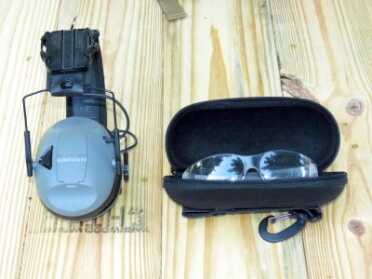
You need to have good safety equipment to compete. Good ear muffs and eye protection will not only keep you safe but help make the experience enjoyable.
I would be remiss if I didn’t mention the need to have some basic safety items for you and your rifle before you even hit the range. Pretty much every match that I have been to has required that you have ear and eye protection as well as an empty chamber indicator. When it comes to ear protection I almost always recommend electronic ear muffs, they’re going to allow you to communicate better with the RO’s, other competitors, and be safer in general since you can maintain some situational awareness. The prices on electronic ear muffs have come down considerably over the years but if you don’t wish to spend that much a good set of Peltor Shotgunner ear muffs are about $20. Eye protection is going to be a personal choice based on style and comfort but I’ve always been happy with the 3M safety glasses available at many ranges and hardware stores. They’re low profile and fit underneath the ear muffs very comfortably, good enough for all day wear.
To carry all of this stuff you’re going to want a pack and I caution you not to get the most gargantuan pack that you can get. Something about the size of a typical three-day assault pack is plenty big to carry the shooting gear plus some additional items like water and clothing if need be.
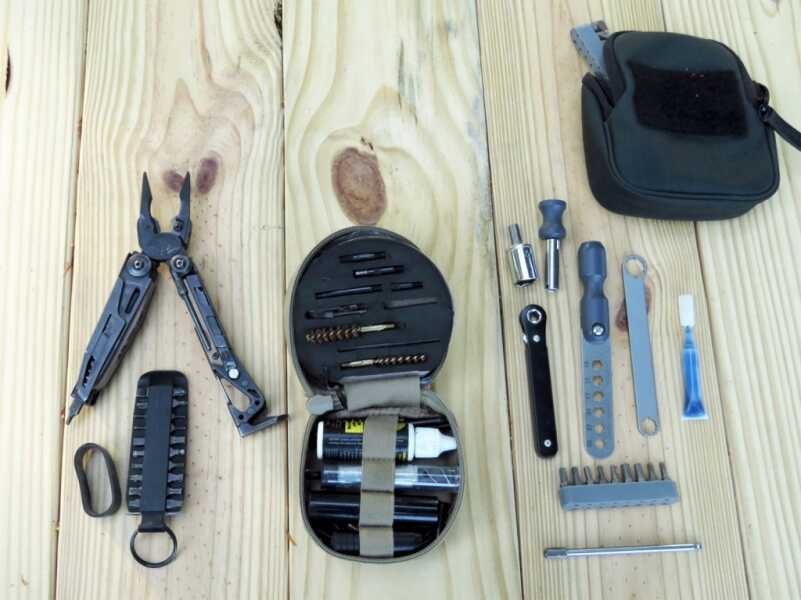
While it’s not absolutely necessary to carry these tools with you when you head to a match they are helpful to have.
Skill Sets
Now that you have the rifle, the scope, and the gear to go along with it there is some basic skill sets you’re going to want to have a grasp of before you hit your first match.
Firstly, before your first match get familiar with all of your new equipment. I cannot tell you how many times I’ve interacted with shooters that didn’t know how to use their scope, use their weather meter, or really know anything about the ammunition they were shooting. I always took the time to help them out but this lack of preparation slows the progress of a match way down and it makes for a long day. An ounce of preparation will go a long way.
Secondly, be able to shoot a 1-inch five-shot group at 100 yards. Obviously, the rifles and ammunition that we have today are easily capable of meeting this accuracy requirement but when you add the human element this can sometimes get dubious. Being able to shoot a 1-inch group at 100 yards will mean you have a firm grasp on the fundamentals of marksmanship, which will give you a better chance of hitting those long range targets.
Lastly, practice getting into alternate shootings positions such as the sitting and kneeling, as well as shooting from barricades. These matches love to throw in all types of shooting positions to test a shooter’s skill and this is often where points can be gained. The first time you approach one of these situations shouldn’t be at the match. I’m not saying you have to be a master at positional shooting but even just knowing to lift your firing knee up so you can brace your elbow against it can pay dividends at a barricade.
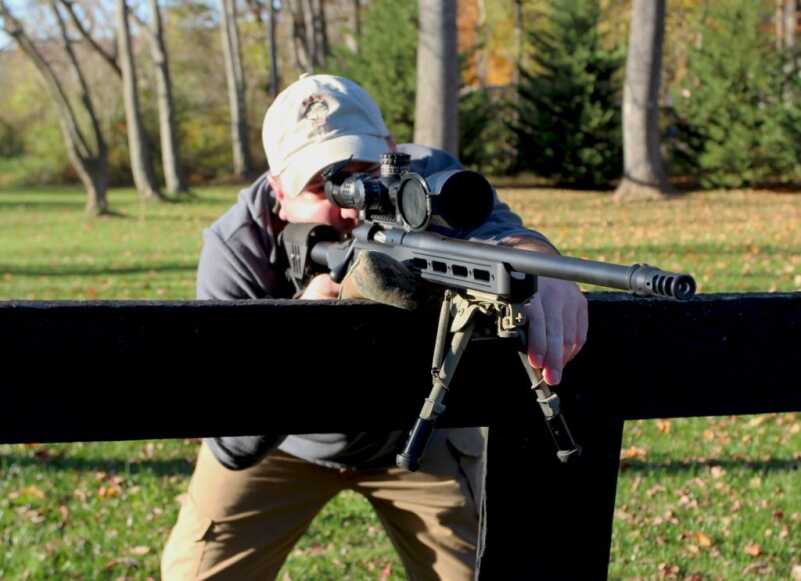
In this croutched position note the legs spread shoulder width apart, the rear bag supporting the front, and the support hand placement pulling the rifle slightly back into the fence.
Takeaway Lessons
Hopefully you now have a little better idea of what you’ll need to get started in precision rifle competitions. As you may have caught on it’s not all about the gear and for the first timer it can be a little overwhelming. To help with this many match directors will make it a point to try to identify and pair up new shooters with more experienced ones so that they can be shown the ropes. Competing in precision rifle matches has allowed me to meet some of the best people that I know and I’m sure you’ll experience much of the same along your journey.
For more information about PRS and where to find a match, click here.
To learn more about scopes and whether you should get a first focal plane, click here.
To learn more about what to look for when selecting a bipod, click here.


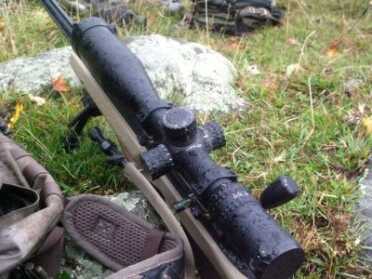
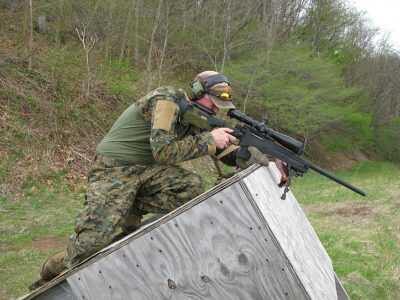
Finally information about prc matches. Thank you
When it comes to bolt guns wth a 10 round magazine. Left Handers have almost no choices. It would be nice to see more manufacturers make these Rifles Left Handed.